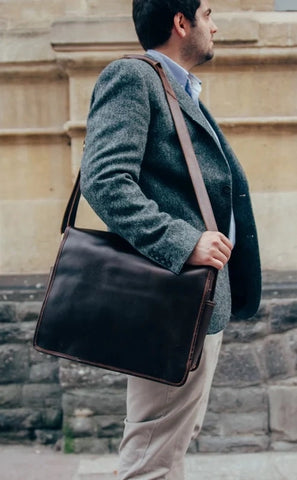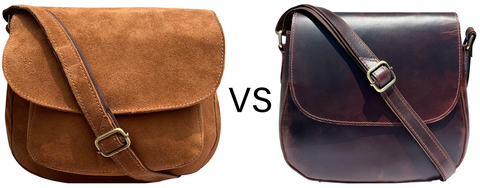Leather vs Suede: What’s the Difference?
- Home
- Editor's Desk
- Leather vs Suede: What’s the Difference?
- ALL PRODUCTS
- BACKPACKS
- Best Sellers
- BUSINESS PORTFOLIOS
- Chef Collectibles
- For the Writers
- For Your Business
- for-the- travels
- KNIFE ROLLS
- LEATHER JOURNALS
- MEN WALLETS
- MESSENGER BAGS
- MISCELLANEOUS
- New arrivals
- PENCIL CASES
- Rustic Town X Women
- SATCHEL
- TOILETRY BAGS
- TRAVEL BAGS
- Travel Essentials
- Watch Case
- WOMEN BAGS
- ##bound
- #2024
- #aestheticjournal
- #AffordableLeatherGoods
- #AirlineGuidelines
- #americanbisonvsbuffalo
- #americanbuffalovsbison
- #AmericanWildlife
- #antiquejournal
- #apron
- #ApronComfort
- #ApronCraftsmanship
- #ApronFashion
- #ApronInspiration
- #ApronProtection
- #aprons
- #ApronStyle
- #ArtisanApron
- #ArtisanLeather
- #ArtOfWriting

In the world of fashion and functionality, the materials we choose for our accessories can define both style and practicality. Leather and suede have long been staples in the production of various high-quality goods, including the versatile satchel. In this blog, we'll dive deep into what these materials are, their properties, how they're made, and their implications in fashion and sustainability. Let's unravel the essence of leather and suede and explore how these materials influence our choices in accessories.
What is Leather?
Leather is a durable and flexible material created by tanning animal rawhides and skins. The most common raw material is cattle hide. It can be produced at manufacturing scales ranging from cottage industry to heavy industry.
Characteristics of Leather
Leather is renowned for its durability, strength, and ability to age gracefully. It is naturally resistant to abrasion and can be treated to be water-resistant, making it ideal for a variety of uses in fashion, luggage, furniture, and other goods. Its texture can vary significantly depending on the finish and the treatment it undergoes.
Pros & Cons of Leather
Pros:
- Durability: Leather is incredibly durable, often lasting for decades with proper care.
- Aesthetics: It ages well, often developing a patina that is highly sought after.
- Versatility: Available in various finishes, leather can be adapted for both casual and formal uses.
Cons:
- Cost: Quality leather products can be quite expensive.
- Maintenance: Requires regular conditioning and care.
- Ethical Concerns: Animal welfare and environmental impact are significant concerns in leather production.
Types of Leather
Leather types are distinguished by the process and the part of the hide used:
- Full-grain leather retains the entire grain layer, displaying the hide's natural markings and grain.
- Top-grain leather is slightly thinner, with fewer natural marks.
- Split leather comes from the lower layers of the hide and is often used to make suede.
- Bonded leather consists of leftover hide bits bonded together with adhesives.
What is Suede?
Suede is a type of leather with a napped finish, commonly made from the underside of the animal skin, which gives it a soft, velvety texture.
Characteristics of Suede
Suede is softer and more pliable than full-grain leather but is also more vulnerable to damage from moisture and staining. Its texture offers a unique, luxurious feel that makes it popular for clothing, shoes, apron, hobo bags, and fashion accessories.
Pros & Cons of Suede
Pros:
- Softness: Extremely soft and comfortable against the skin.
- Fashionable: Its texture adds a touch of elegance and style.
Cons:
- Delicate: More susceptible to damage and harder to maintain.
- Water Sensitivity: Prone to staining and water damage.
Types of Suede
- Genuine suede is made from the underside of animal skins, primarily lamb, although goat, pig, calf, and deer are also used.
- Suede leather is made from the inner splits of a hide that have been sanded and treated.
- Microsuede is a synthetic version, made from microfiber fabric designed to mimic genuine suede.
How are Suede and Leather Made?
The primary method of creating leather and suede involves tanning, a chemical process that stabilizes the proteins in the raw hide to prevent it from decomposing. Leather is usually produced using either vegetable tanning, which uses organic materials and is more environmentally friendly, or chrome tanning, which uses chromium salts and is faster but less sustainable.
Suede, on the other hand, is made from the underside of the skin that has been split from the top-grain. It is then buffed and sanded to create its characteristic soft, fuzzy surface. The process of making suede is generally like leather but focuses on softening and treating the material to enhance its plush texture.
What are the Main Differences Between Suede and Leather?
- Texture: Leather has a smooth, hard surface; suede has a soft, velvety touch.
- Durability: Leather is tougher and more resistant to elements, while suede is more delicate.
- Uses: Leather is favored for items that require durability like shoes, travel bags, briefcase, belts, and jackets. Suede is chosen for its aesthetic appeal in fashion items such as dress shoes, women's apparel, apron, and handbags.
Which is More Sustainable, Suede or Leather?
The production of both suede and leather involves significant environmental challenges. The tanning process, particularly chrome tanning, can release toxic chemicals that may harm the environment. However, as a by-product of the meat industry, using these materials can be seen as making use of otherwise wasted skins.
Advancements in tanning technology and growing interest in organic and sustainable practices have led to more environmentally friendly leather and suede production methods. These include vegetable tanning and the use of recycled materials.
How Should Suede and Leather Be Cared For?
Maintaining leather and suede is crucial to ensure their longevity:
- Leather Care: Clean regularly with a damp cloth, use a suitable leather conditioner to keep it supple, and store in a cool, dry place.
- Suede Care: Use a suede brush to maintain its nap, apply a water and stain repellent, and handle stains promptly using a special suede eraser.
The use of protective sprays is particularly important for suede, given its vulnerability to water and stains.
What are the Fashion Implications of Choosing Suede vs Leather?
Exploring how each material fits into current fashion trends reveals that leather is often viewed as a classic, durable choice for everyday and high-end fashion. It provides a polished look that is unmatched in terms of durability and timeless style. Suede, while equally fashionable, offers a softer, more nuanced appearance that exudes luxury and comfort. Its texture and appearance make it suitable for seasonal trends, particularly in fall and winter collections.
What are the Cost Implications of Choosing Suede vs Leather?
While suede is often less expensive upfront, its need for frequent care and the potential for quick wear might increase its total cost of ownership compared to leather. Leather, though initially more costly, tends to be a better long-term investment due to its durability.
Conclusion
Understanding the differences between suede and leather, their production, and their care is essential for making informed decisions about which material to choose for your next accessory. Whether your priority lies in durability, style, or environmental impact, both materials offer unique benefits and challenges.
FAQ
Q: Is suede less durable than leather?
A: Yes, suede is generally less durable and more prone to damage from stains and water.
Q: Can I waterproof my suede and leather accessories?
A: Yes, there are various products available that can help waterproof suede and leather, though it's important to use products specifically designed for each material.
Q: Are there vegan alternatives to leather and suede?
A: Yes, synthetic options like faux leather and microsuede offer vegan alternatives that mimic the properties of real leather and suede.
Q: How often should I condition my leather goods?
A: It's recommended to condition leather goods every 3 to 6 months, depending on usage and the environment.
Related Blog Posts:
Why Leather is Good?
How Leather Is Tanned Naturally: A Comprehensive GuideHow do I care for my leather bag to ensure its longevity?















